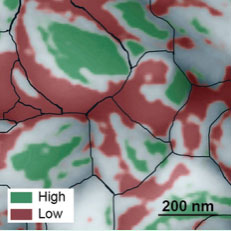
Scientific Achievement
A multidisciplinary team of staff and users at the Molecular Foundry are now able to differentiate high performing areas on perovskite solar cells that approach the material’s theoretical energy conversion limit of 31%
Significance and Impact
These top-performing facets could hold the secret to highly efficient perovskite solar cells if the material can be synthesized so that only very efficient facets develop.
Research Details
- Perovskite solar cells are inexpensive and easy to fabricate, and have already shown the ability to operate nearly as efficiently as silicon.
- Photoconductive atomic force microscopy was used to map photovoltaic efficiency of perovskite solar cells by measuring photocurrent generation and open circuit voltage.
- The experiment revealed a bumpy surface composed of grains about 200 nanometers in length, and each grain has multi-angled facets like the faces of a gemstone.
- Unexpectedly, a significant difference in energy conversion efficiency was found between facets on individual grains. Poorly performing facets were found adjacent to highly efficient facets, with some facets approaching the material’s theoretical energy conversion limit of 31 percent.

